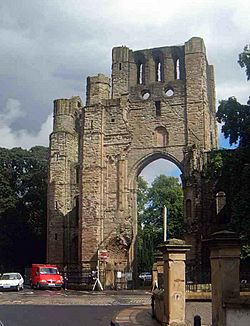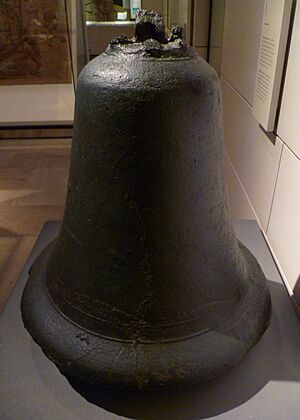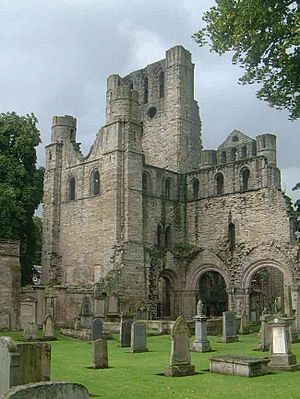Kelso Abbey facts for kids

Kelso Abbey
|
|
| Monastery information | |
|---|---|
| Full name | Kelso Abbey |
| Order | Tironensian |
| Established | Community first established at Selkirk c. 1113, moved to Kelso 1128. |
| Disestablished | 1559 |
| People | |
| Founder(s) | David I of Scotland |
| Site | |
| Location | Kelso, Scottish Borders, Scotland |
| Visible remains | Fragments: Western Crossing, Infirmary. |
| Public access | Yes |
Kelso Abbey is a ruined abbey located in Kelso, Scotland. It was built in the 12th century by a group of Tironensian monks. These monks were first brought to Scotland during the time of King Alexander I. The abbey stands on land overlooking where the Tweed and Teviot rivers meet. This spot was once the important town of Roxburgh, which was planned to be a main center for the Scottish kingdom in the south. Because of its location, Kelso Abbey became a very powerful religious center in the Scottish Borders.
Over the years, Roxburgh was often attacked and taken over by English forces. The monks at Kelso Abbey managed to survive these changes in control. They rebuilt the abbey after it was damaged and kept its Scottish identity. After 1460, life at the abbey became more peaceful. However, it faced new attacks in the early 1500s. By the middle of that century, due to many difficult events, the abbey stopped working and its buildings became ruins.
Even though the site of Kelso Abbey has not been fully dug up by archaeologists recently, it seems it was a very large building. It likely had two main crossing areas. Today, only the west tower crossing and part of the old hospital (called an infirmary) are still standing. The huge size and strong Romanesque style of the tower show that it was a very big and powerful building. It even looked a bit like a fort, which tells us how important Roxburgh was when the abbey was at its strongest.
Contents
Building Kelso Abbey
Kelso Abbey was started in Roxburgh in 1128. It was built by monks from the Tironesian order, who came from Tiron, a place near Chartres, in France. These monks first arrived in Scotland around 1113. They were supported by David I, who was then a prince. At first, the monks were asked to build their community near Selkirk. It is not clear why they left this first site in 1128. However, David, who was now the King of Scots, was making Roxburgh a major center for trade and government in Southern Scotland. He also set up other important places in Roxburgh, like the royal mint (where coins were made).
Building the abbey probably began right away. By 1143, enough work was done for the building to be officially dedicated. It was named in honor of the Blessed Virgin Mary and Saint John. The King's son, Henry, Earl of Northumbria, who died before his father, was buried at the abbey in 1152.
Growth and Challenges
Kelso Abbey was built close to Roxburgh Castle, across the Tweed river. It quickly became one of the richest and grandest abbeys in Scotland. Much of its money came from its large land holdings in the Border country. John, who was the abbot of Kelso from 1160 to 1180, was the first abbot in Scotland to be given the mitre, a special hat worn by bishops and abbots.
Later, during the time of King William I, Scotland's royal family lost control of Northumbria. This meant David's southern "capital" became very close to the border with England. Because of this, it was often attacked during the Wars of Scottish Independence. In 1299, the abbot of Kelso was an Englishman named Thomas de Durham. However, the abbey worked to keep its Scottish identity. During these troubled times, Roxburgh Castle and Berwick upon Tweed, a major Scottish port, were often held by the English. Whenever the abbey was attacked, the monks would repair the damage.
In 1460, James II died near the abbey. This happened because of an accident during a battle to take back Roxburgh Castle that same year. The young king, James III, was quickly crowned at Kelso Abbey soon after. From 1460 to 1513, the area was more peaceful, and life at the abbey was likely calm. But after 1517, it was again attacked by the English.
Destruction in the 1500s
Kelso Abbey stopped working as an abbey because of several events in the mid-1500s. First, in the 1540s, the building was badly damaged. This happened during attacks ordered by the English king, Henry VIII. These attacks were part of a period called the Rough Wooing. During this time, many abbeys in southern Scotland, like those at Melrose, Dryburgh, and Jedburgh, were destroyed by forces led by the Earl of Hertford. There were even plans by an Italian engineer, Archangelo Arcano, to turn the Abbey into a strong fort for Henry VIII.
In 1554, Mary of Guise, who was ruling Scotland at the time, sent building lime to Kelso. This was stored in the monks' vaults, possibly to help repair the fort rather than the abbey itself. The Scottish Reformation in 1560 officially ended the monastic system. From this time, the Tironensian community at Kelso was no longer recognized. A small group of monks might have stayed at the site for some years after 1560. However, after more attacks and damage, the abbey was officially declared abandoned in 1587. Francis Stewart, 5th Earl of Bothwell had a house at the Abbey, and King James VI visited in January 1591.
By the late 1500s, the lands that once belonged to the monastery were fully controlled by non-religious people. In 1607, these lands were finally given as a secular lordship, called Holydean, to Robert Ker of Cesford, who was the last person in charge of the abbey's income.
After the Reformation
Between 1647 and 1771, a part of the abbey ruins was used as a parish church. Other parts of the building were taken apart, and the stones were used by local people to build houses in the town of Kelso. The church built after the Reformation seemed to be a small, arched structure placed inside the west transepts around 1748. This changed building also included an arched gaol (jail).
In 1805, large sections of the ruins were cleared away. This included the parish church and the jail. Only the abbey's west tower and transept remain today. A more recent addition, built in 1933, is a memorial cloister for the 8th Duke of Roxburghe. It was designed by Reginald Fairlie to look like the original cloisters when the abbey was first built.
Burials at Kelso Abbey
- Prince Henry of Scotland (1114–1152), who was the Earl of Northumbria and Huntingdon.
- Several of the Dukes of Roxburghe and members of their family.
Visiting Kelso Abbey
The ruins of Kelso Abbey are looked after by Historic Scotland. There is no charge to enter and explore the site.
Tourism and Walks
Kelso Abbey is one of five abbeys and historic sites in southern Scotland that are part of the Borders Abbeys Way walking trail.
More to Explore
- Kelso
- Abbot of Kelso (for a list of the abbots and leaders of the abbey)
- List of religious houses in Scotland
- List of places in the Scottish Borders
- List of places in Scotland
- Borders Abbeys Way
- Kilwinning Abbey
See also
 In Spanish: Abadía de Kelso para niños
In Spanish: Abadía de Kelso para niños




